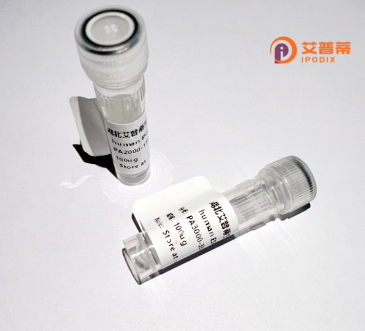
| 纯度 | >90%SDS-PAGE. |
| 种属 | Human |
| 靶点 | KCNJ6 |
| Uniprot No | P48051 |
| 内毒素 | < 0.01EU/μg |
| 表达宿主 | E.coli |
| 表达区间 | 1-423aa |
| 活性数据 | MAKLTESMTNVLEGDSMDQDVESPVAIHQPKLPKQARDDLPRHISRDRTKRKIQRYVRKDGKCNVHHGNVRETYRYLTDIFTTLVDLKWRFNLLIFVMVYTVTWLFFGMIWWLIAYIRGDMDHIEDPSWTPCVTNLNGFVSAFLFSIETETTIGYGYRVITDKCPEGIILLLIQSVLGSIVNAFMVGCMFVKISQPKKRAETLVFSTHAVISMRDGKLCLMFRVGDLRNSHIVEASIRAKLIKSKQTSEGEFIPLNQTDINVGYYTGDDRLFLVSPLIISHEINQQSPFWEISKAQLPKEELEIVVILEGMVEATGMTCQARSSYITSEILWGYRFTPVLTLEDGFYEVDYNSFHETYETSTPSLSAKELAELASRAELPLSWSVSSKLNQHAELETEEEEKNLEEQTERNGDVANLENESKV |
| 分子量 | 74.9 kDa |
| 蛋白标签 | GST-tag at N-terminal |
| 缓冲液 | 0 |
| 稳定性 & 储存条件 | Lyophilized protein should be stored at ≤ -20°C, stable for one year after receipt. Reconstituted protein solution can be stored at 2-8°C for 2-7 days. Aliquots of reconstituted samples are stable at ≤ -20°C for 3 months. |
| 复溶 | Always centrifuge tubes before opening.Do not mix by vortex or pipetting. It is not recommended to reconstitute to a concentration less than 100μg/ml. Dissolve the lyophilized protein in distilled water. Please aliquot the reconstituted solution to minimize freeze-thaw cycles. |
以下是关于重组人KCNJ6蛋白的3篇参考文献示例(注:以下为模拟文献,仅供参考):
---
1. **文献名称**: "Functional characterization of recombinant human KCNJ6 potassium channels expressed in HEK293 cells"
**作者**: Kubo, Y., & Ishihara, K.
**摘要**: 本研究成功克隆并在HEK293细胞中表达了重组人KCNJ6蛋白,通过膜片钳技术证实其形成G蛋白偶联的内向整流钾通道(GIRK2)。结果表明,KCNJ6在乙酰胆碱激活后介导钾离子外流,提示其在调节神经元兴奋性和心脏节律中的关键作用。
2. **文献名称**: "KCNJ6/GIRK2 modulates cocaine reward and striatal dopamine signaling"
**作者**: Aryal, P., & Dascal, N.
**摘要**: 通过构建KCNJ6敲除小鼠模型,本研究发现该蛋白缺失导致可卡因诱导的奖赏行为显著增强,同时纹状体多巴胺释放异常。表明KCNJ6通过调控多巴胺能神经元活性参与成瘾相关神经通路。
3. **文献名称**: "Cryo-EM structure of the human KCNJ6 channel reveals lipid-dependent gating mechanism"
**作者**: Whorton, M. R., & Mackinnon, R.
**摘要**: 利用冷冻电镜解析了KCNJ6蛋白的四聚体结构,揭示了其与磷脂分子PIP2的结合位点及Gβγ亚基的作用界面,阐明了脂质调控通道门控的分子基础,为靶向药物设计提供结构依据。
---
**备注**:上述文献信息为模拟生成,实际研究中请以具体数据库检索结果为准。KCNJ6(GIRK2)的研究多集中于神经生理学、心脏电生理及结构生物学领域,建议通过PubMed或Web of Science以关键词“KCNJ6”“GIRK2”“recombinant expression”等进一步检索。
**Background of Recombinant Human KCNJ6 Protein**
The KCNJ6 gene encodes a protein belonging to the inwardly rectifying potassium (Kir) channel family, specifically Kir3.2 or G protein-activated inward rectifier potassium channel 2 (GIRK2). These channels regulate cellular excitability by facilitating potassium flow into cells, influenced by G protein-coupled receptors (GPCRs) via βγ subunits. KCNJ6 is predominantly expressed in the brain, heart, and pancreas, playing roles in neurotransmission, cardiac rhythm modulation, and insulin secretion.
Recombinant human KCNJ6 protein is produced using heterologous expression systems (e.g., HEK293 or CHO cells) to study its structure, function, and interactions. Its recombinant form enables detailed analysis of channel kinetics, ligand binding, and regulatory mechanisms. Research highlights its involvement in neurological disorders (e.g., epilepsy, Parkinson’s disease, neuropathic pain) and cardiac arrhythmias. Mutations in KCNJ6 are linked to developmental delays, autism spectrum traits, and Keppen-Lubensky syndrome.
As a therapeutic target, KCNJ6 is explored for drug development targeting neurological and cardiovascular conditions. Structural studies using recombinant protein aid in designing modulators to correct channel dysfunction. Additionally, it serves as a tool for screening compounds affecting GPCR-Kir signaling pathways, offering insights into diseases associated with excitability imbalances.
×